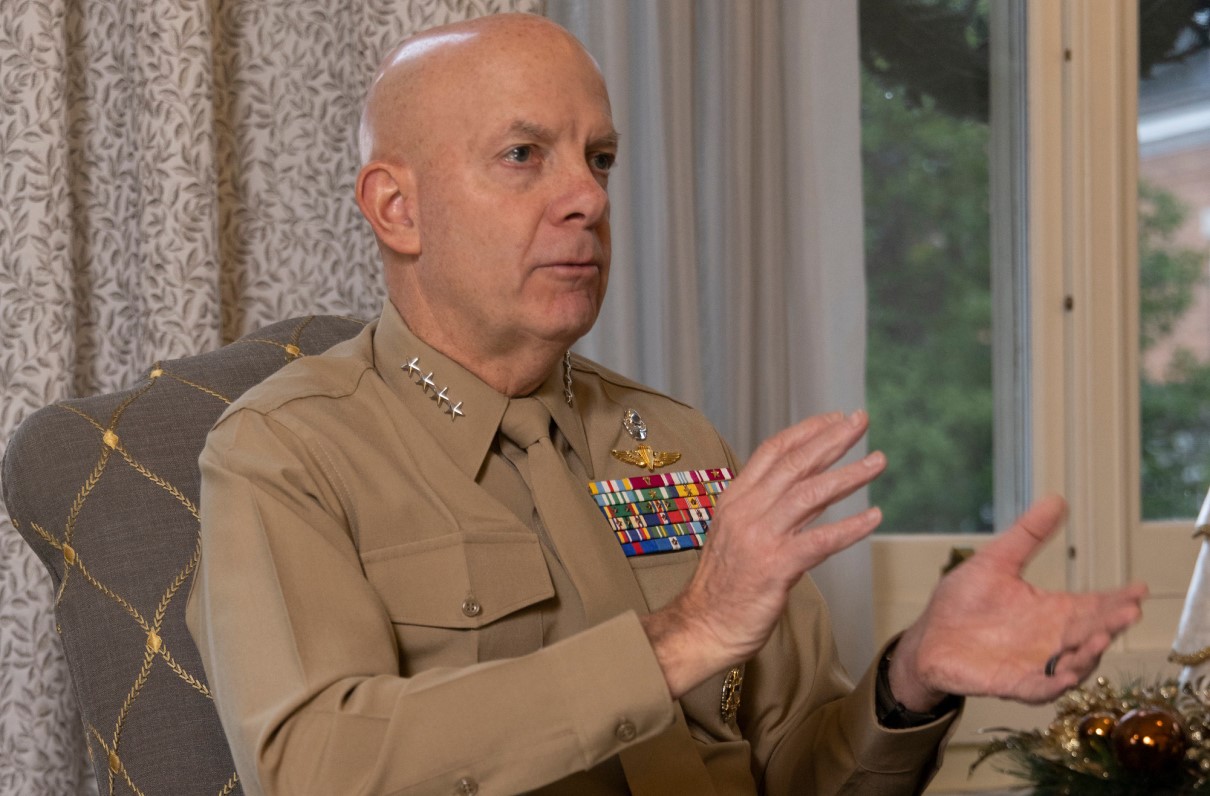(This article originally appeared in the April 2023 issue of Military Officer, a magazine available to all MOAA Premium and Life members. Learn more about the magazine here; learn more about joining MOAA here.)
This summer, Marine Corps Commandant Gen. David H. Berger will complete his four-year term as commandant. It was a stint largely defined by his Force Design 2030 plan, a roadmap for the Corps’ future that has seen its share of both praise and criticism.
“There are some who characterize it as a more technical force or a force that’s more reliant on technology,” Berger said of Force Design 2030. “I would say that’s not accurate at all. It’s just employing technology that’s available now that wasn’t available 10 years ago. That aspect of becoming a Marine, the values, the physical part, the persistence, the perseverance to push through obstacles, those are enduring. They don’t change.”
What made Berger become a Marine? A drill instructor at Tulane University in Louisiana where he was enrolled in the Navy ROTC program to pay for college.
“From his uniform to carriage to poise to just confidence and leadership, [I said] ‘that’s what I want to do,’ ” said Berger, who became a Marine in 1981.
During his 42-year military career, his commands included Regimental Combat Team 8 in Fallujah, Iraq, and 1st Marine Division (Forward) in Afghanistan.
In an interview with Military Officer, Berger spoke about recruiting and retention, gender integration at boot camp, and what he considers the biggest accomplishment of his decorated military career. This interview has been edited for length and clarity.
Q. With the rollout of the Commandant’s Retention Program, the focus seems to have shifted from recruitment to retention. How do you ensure an older Corps in 2030 doesn’t disadvantage the Corps of 2040 or 2050?
A. I’m not at all concerned about aging the force, turning us into irrelevancy, or anything like that. I would say … maturing the force is what we need. That may be a function of years or more likely a function of how much experience and skills and intellectual capacity we can put in somebody’s brain. And we’re probably going to do that by educating and training in different ways than we have in the past.
Q. Are there specific ways you want to incentivize Marines to re-enlist?
A. Your role as a recruiter is to try to understand the person first … . You spend a lot of time up front trying to figure out the person, what’s important to them, what parts, what values, what benefits are going to matter the most. We have to approach retention in the same way. It can’t be one-size-fits-all — like everybody of this grade and everybody with this experience and everybody with a skill set gets a certain amount of money. What we need to be doing is saying: “What would it take for you to stay in?” And then, in a conversation, I’m going to learn from you that it might be money. It might be a move to some location you always wanted to go to. It could be a school. It could be a job change to another career track. We have to focus on what’s important to the individual. That’s how we’ll retain them.
[MOAA INTERVIEW: Adm. Linda Fagan, Coast Guard Commandant]
Q. Define what gender integration during boot camp looks like to you, and what are the challenges to getting there in the next few years?
A. Until a few years ago, all of the female recruit training was done on the East Coast only. And all of it was done in one battalion only. So what does gender integration mean to me? It means during the bulk of recruit training that males and females see each other. They’re not locked off in different battalions with different instructors now, training on both coasts, training within every company to the extent we can with recruiting males and females. A big portion of recruit training in the Marine Corps happens in the barracks. That instruction from drill instructor cadre to recruits is 24 hours a day. So what does gender integration look like? It’s not separating them into different units and different coasts.
The biggest challenge has been producing enough female drill instructors to do it on both coasts, across multiple battalions because we were geared for one battalion on one coast. Creating enough drill instructors at a sustainable rate where you can do it — at times, two in multiple units — has been the biggest challenge. It’s not a culture thing. It’s not a bias thing. It’s frankly producing enough female drill instructors without breaking the rest of the force. Because we could go out and grab females from all parts of the Marine Corps and bring them to the two recruit depots, but then we would pull them out of units. We don’t want to do that. It has to be sustainable.
[MOAA INTERVIEW: Gen. Charles Q. Brown Jr., Air Force Chief of Staff]
Q. What do you consider your biggest accomplishment during your military career?
A. I think you want something that’s enduring, no matter what vocation that you’re in. And I think in our vocation it’s people. So what gives me the most pride? Marines who I have served around that went on to do things they maybe didn’t think was possible or was beyond them. It’s nothing that I’ve accomplished, but I think the Marine Corps has instilled in me that your legacy is not you; your legacy is the Marines around you.
Military Officer Magazine
Discover more interesting stories in MOAA's award-winning magazine.

